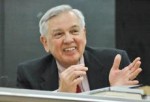Lecturer gets creative on origins of life

Spaghetti monsters and Pastafarian pirates – contemporary spoofs of creationism – were nowhere to be found during a lecture on intelligent design at USF’s University Lecture Hall on Thursday.
Nearly 200 people attended the lecture – “Origins: Who Needs Faith?” – which was the first in a two-part series. The second part will take place Thursday from 7 p.m. to 10 p.m. at the University Lecture Hall.
The lecture included a PowerPoint presentation dealing with scientific defenses of intelligent design. The event, hosted by the student organization Sowers of the Seed, looked at the natural world to decide if it is a product of natural forces or intelligent design and discussed whether intelligent design has a place in science.
The lecture featured H.E. Payne Jr., who holds a doctorate in mathematics from USF, as the speaker. Douglas Northcutt, a biology professor at Florida College; Howard Colvin, who has a doctorate in organic chemistry; and John Coffman, who holds master’s degrees in physics and math, made up the discussion panel following the speech.
Payne began by emphasizing the secular nature of the lecture, saying it would be fully reliant on science and leave the audience to determine which theory makes more sense after the evidence was presented.
“Usually, we all tend to see what we expect to see whenever we approach this subject with our own presuppositions,” he said. “There is no room for philosophy or religion in this discussion, only science.”
Payne showed a model from William Dembski’s book The Design Inference, which can be used to determine the likelihood of an object being designed intelligently. This model was challenged during the discussion panel by members of the Freethinkers Club at USF for being unscientific.
“The model was pseudoscience and unable to be criticized,” said Joe Oberfrank, an education major at USF.
The concluding argument Payne gave for intelligent design was the example of the human DNA strand. Because it is a double helix with crossbars that contains a certain characteristic structure he described as contingent, complex and specified, the double helix meets Dembski’s model, and is thus the likely product of intelligent design, Payne said.
The open panel discussion prompted many questions from the audience, especially from those pursuing careers in science. In regards to the DNA example, one audience member mentioned that 90 percent of human DNA was actually junk and questioned whether it was intelligently designed. Payne responded that several recent studies have shown that even this “junk” DNA has some purpose.
Another student wanted to know where to find scientific experiments that proved intelligent design. No one on the panel was able to cite an experiment, though they said such studies were currently underway.
Rachel Vistein, secretary of the Freethinkers Club and a senior in biology, complained that the panelists dodged her questions and did not let her finish asking them.
“Evolution’s intent is to address the diversity of life, not the origin,” she said. “Evolution is defined as a variation of change in allele frequencies (different forms of the same gene) and those variations between populations both physically and temporally through time.”
The second part of the lecture will take place Thursday in the University Lecture Hall from 7:30 p.m. to 9:30 p.m.






